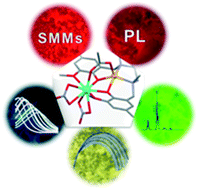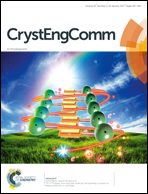Rational design of triple-bridged dinuclear ZnIILnIII-based complexes: a structural, magnetic and luminescence study†
Abstract
Twelve novel dinuclear ZnII–LnIII complexes of general formula [Zn(μ-L)(μ-OAc)Ln(NO3)2] (LnIII = Y (1), Pr (2), Nd (3), Sm (4), Eu (5), Gd (6), Tb (7), Dy (8), Ho (9), Er (10), Tm (11), Yb (12)) have been prepared from the symmetric compartmental Mannich base ligand N,N′-dimethyl-N,N′-bis(2-hydroxy-3-methoxy-5-methylbenzyl)-ethylenediamine (H2L). Structural determinations indicate that in all these complexes, ZnII ions are pentacoordinated in the inner position of the ligand, linked to two nitrogen and two oxygen atoms from L2− and a bridging syn–syn acetate group. The LnIII ions are nonacoordinated in the outer position, linked to four oxygen atoms from L2−, two bidentate nitrate anions and the bridging acetate. Complexes 3, 6, 7, 8, 10 and 12 exhibit field induced slow relaxation of the magnetization. It should be remarked that this behaviour is very infrequent in GdIII and NdIII coordination compounds. For compounds 8 and 12, it was possible to extract the effective energy barrier (Ueff) for the reversal of the magnetization, with a value of 27.5 K (52.6 K considering the Raman relaxation process in addition to the Orbach mode) and 13.2 K for DyIII and YbIII compounds, respectively. Moreover, the photophysical properties of these complexes have been studied at different temperatures and show that L2− is able to sensitize luminescence emission of many lanthanide ions. SmIII, EuIII, TbIII, DyIII and TmIII-based compounds show fluorescence in the visible region, whereas the YbIII-based one is sensitized in the near-infrared (NIR) region. Therefore, complexes 7, 8 and 12 may be considered as dual magneto-luminescent materials.



 Please wait while we load your content...
Please wait while we load your content...